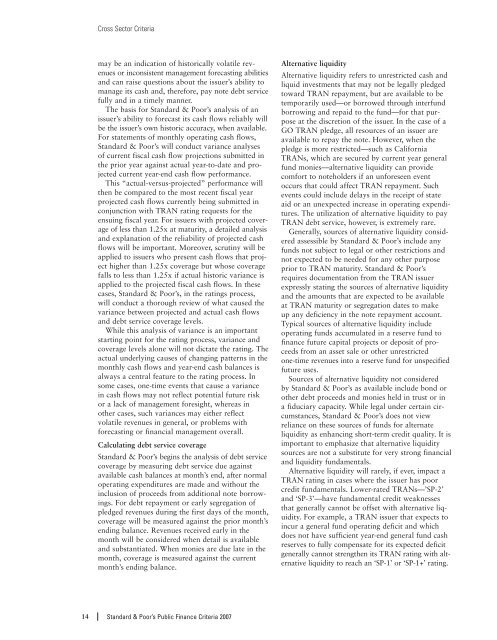S&P - Public Finance Criteria (2007). - The Global Clearinghouse
S&P - Public Finance Criteria (2007). - The Global Clearinghouse
S&P - Public Finance Criteria (2007). - The Global Clearinghouse
You also want an ePaper? Increase the reach of your titles
YUMPU automatically turns print PDFs into web optimized ePapers that Google loves.
Cross Sector <strong>Criteria</strong>may be an indication of historically volatile revenuesor inconsistent management forecasting abilitiesand can raise questions about the issuer’s ability tomanage its cash and, therefore, pay note debt servicefully and in a timely manner.<strong>The</strong> basis for Standard & Poor’s analysis of anissuer’s ability to forecast its cash flows reliably willbe the issuer’s own historic accuracy, when available.For statements of monthly operating cash flows,Standard & Poor’s will conduct variance analysesof current fiscal cash flow projections submitted inthe prior year against actual year-to-date and projectedcurrent year-end cash flow performance.This “actual-versus-projected” performance willthen be compared to the most recent fiscal yearprojected cash flows currently being submitted inconjunction with TRAN rating requests for theensuing fiscal year. For issuers with projected coverageof less than 1.25x at maturity, a detailed analysisand explanation of the reliability of projected cashflows will be important. Moreover, scrutiny will beapplied to issuers who present cash flows that projecthigher than 1.25x coverage but whose coveragefalls to less than 1.25x if actual historic variance isapplied to the projected fiscal cash flows. In thesecases, Standard & Poor’s, in the ratings process,will conduct a thorough review of what caused thevariance between projected and actual cash flowsand debt service coverage levels.While this analysis of variance is an importantstarting point for the rating process, variance andcoverage levels alone will not dictate the rating. <strong>The</strong>actual underlying causes of changing patterns in themonthly cash flows and year-end cash balances isalways a central feature to the rating process. Insome cases, one-time events that cause a variancein cash flows may not reflect potential future riskor a lack of management foresight, whereas inother cases, such variances may either reflectvolatile revenues in general, or problems withforecasting or financial management overall.Calculating debt service coverageStandard & Poor’s begins the analysis of debt servicecoverage by measuring debt service due againstavailable cash balances at month’s end, after normaloperating expenditures are made and without theinclusion of proceeds from additional note borrowings.For debt repayment or early segregation ofpledged revenues during the first days of the month,coverage will be measured against the prior month’sending balance. Revenues received early in themonth will be considered when detail is availableand substantiated. When monies are due late in themonth, coverage is measured against the currentmonth’s ending balance.Alternative liquidityAlternative liquidity refers to unrestricted cash andliquid investments that may not be legally pledgedtoward TRAN repayment, but are available to betemporarily used—or borrowed through interfundborrowing and repaid to the fund—for that purposeat the discretion of the issuer. In the case of aGO TRAN pledge, all resources of an issuer areavailable to repay the note. However, when thepledge is more restricted—such as CaliforniaTRANs, which are secured by current year generalfund monies—alternative liquidity can providecomfort to noteholders if an unforeseen eventoccurs that could affect TRAN repayment. Suchevents could include delays in the receipt of stateaid or an unexpected increase in operating expenditures.<strong>The</strong> utilization of alternative liquidity to payTRAN debt service, however, is extremely rare.Generally, sources of alternative liquidity consideredassessible by Standard & Poor’s include anyfunds not subject to legal or other restrictions andnot expected to be needed for any other purposeprior to TRAN maturity. Standard & Poor’srequires documentation from the TRAN issuerexpressly stating the sources of alternative liquidityand the amounts that are expected to be availableat TRAN maturity or segregation dates to makeup any deficiency in the note repayment account.Typical sources of alternative liquidity includeoperating funds accumulated in a reserve fund tofinance future capital projects or deposit of proceedsfrom an asset sale or other unrestrictedone-time revenues into a reserve fund for unspecifiedfuture uses.Sources of alternative liquidity not consideredby Standard & Poor’s as available include bond orother debt proceeds and monies held in trust or ina fiduciary capacity. While legal under certain circumstances,Standard & Poor’s does not viewreliance on these sources of funds for alternateliquidity as enhancing short-term credit quality. It isimportant to emphasize that alternative liquiditysources are not a substitute for very strong financialand liquidity fundamentals.Alternative liquidity will rarely, if ever, impact aTRAN rating in cases where the issuer has poorcredit fundamentals. Lower-rated TRANs—’SP-2’and ‘SP-3’—have fundamental credit weaknessesthat generally cannot be offset with alternative liquidity.For example, a TRAN issuer that expects toincur a general fund operating deficit and whichdoes not have sufficient year-end general fund cashreserves to fully compensate for its expected deficitgenerally cannot strengthen its TRAN rating with alternativeliquidity to reach an ‘SP-1’ or ‘SP-1+’ rating.14 Standard & Poor’s <strong>Public</strong> <strong>Finance</strong> <strong>Criteria</strong> <strong>2007</strong>
















